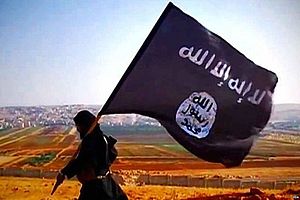Last week, Uzbekistan’s National Security Service (SNB) responded to a series of bomb threats in the Parkent district, outside of the capital, Tashkent. Radio Free Europe/Radio Liberty, based on the reporting of its Uzbek service–Ozodlik–said at the time that on April 25 “a leaflet was found plastered to the window of a secondary school in Parkent. The leaflet, in the Uzbek language but written in Arabic script, contained a threat to blow up the school.”
RFE/RL did not attribute the leaflets to any particular group.
The Fergana Information Agency, a Russian news outlet covering Central Asia, did make an attribution in its coverage: ISIS. For its part, Fergana was repeating claims made on Uzmetronom, which it called an “independent Tashkent-based” website.
How valid are these reports? It’s tremendously difficult to say, but Fergana (and Uzmentronom) call the attribution into question:
Meanwhile, experts interviewed by Uzmetronom completely reject [the theory] that ISIL members or supporters are behind the leaflet distribution. The experts say an unregistered underground cell of a destructive nature could be behind this to sow panic and anxiety in the population’s life. Several experts Fergana interviewed also doubt the ISIL was directly involved in the incident. Our experts also suggest the Uzbek secret services could be the actual distributors of the leaflets in question. After all, given almost unlimited powers police and army enjoy, no underground terrorist organisation can exist in Uzbekistan.
Uzbekistan, which last week made a repeat appearance on the “worst of the worst” section of Freedom House’s latest Freedom of the Press report, is not known for a vibrant independent media. The attribution of the leafletting to ISIS–even as the claims are simultaneously called into question–should be viewed with extreme skepticism. The mention of the ISIS, even with caveats, feeds into a fear narrative not unfamiliar to Central Asia watchers.
Speaking last month at a workshop examining what John Heathershaw and David Montgomery call the “myth of post-Soviet Muslim radicalization in Central Asian republics” Noah Tucker, the Managing Editor of Registan.net, recounted a story that is worth repeating fully here:
… we can look at the way that in the past, for a long time, when the locus of the threat was on the IMU and the need was to expand the danger of the IMU in order to justify domestic policies one of the things that several of the regional governments in particular did was to claim that the IMU was no longer the IMU but it was now the Islamic Movement of Turkestan.
And there’s one country in particular where it is referred to consistently this way in the press and has been for three or four years in spite of the fact that IMU never renamed themselves the Islamic Movement of Turkestan, they’ve never called themselves… this verifiably did not happen. But these governments claimed to have secret sources within the organization that tell them these things that make the threat seem all the more ominous and create this idea that their population is surrounded by this radical Islamic threat.
And now the dialogue about that abruptly changed to ISIS. And the technique has become very similar. In the last three months I’ve lost count of the number of articles that I’ve seen run in state-approved Uzbek press talking about how there is an imminent threat of invasion of Uzbekistan through Turkmenistan…
Tucker also commented “that many of the Central Asian governments deliberately misinform their population about the nature of the threat against them.” His point is essentially that the Uzbek government will seize upon whatever “threat” is scariest. He went on to note that deliberate misinformation is also a hallmark tactic of ISIS–doubling the confusion when trying to get to the truth.
So who posted the leaflets? No one knows, but Uzbek SNB didn’t hesitate to establish checkpoints in the area, stopping and searching cars, and going house to house. Fergana reports that several young men have been detained for possessing ISIS promotional videos, another claim that cannot really be verified.
Last August, a black flag was hung from a bridge in Tashkent. No solid links were made to ISIS and the Arabic word for “Allah” was misspelled on the flag. Uzbekistan has not had a major terrorist attack since a series of suicide bombings in early 2004 in Tashkent and Bukhara claimed by a splinter of the IMU operating out of Pakistan called the Islamic Jihad Union, though the government attributed the attacks to Hizb ut-Tahrir.
Uzbekistan is acutely aware of the drawdown in Afghanistan and the vague threat of the return of the IMU, which is active in Afghanistan and Pakistan and widely discussed in Central Asia. It may be, though, that Uzbek security is more on edge because next week is the tenth anniversary of the Andijan massacre, something the government surely hopes passes quietly.

































